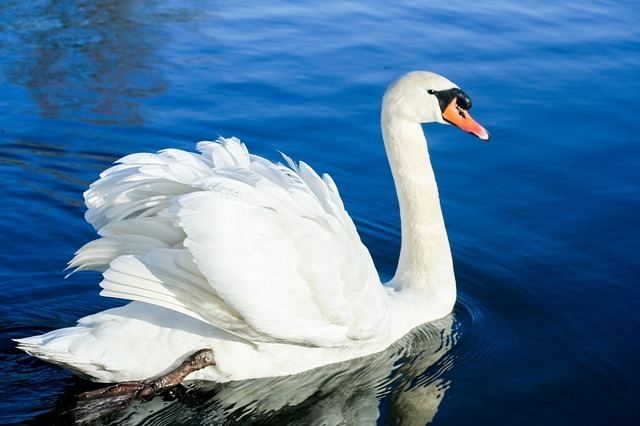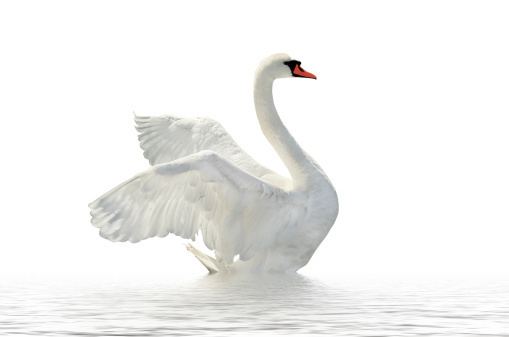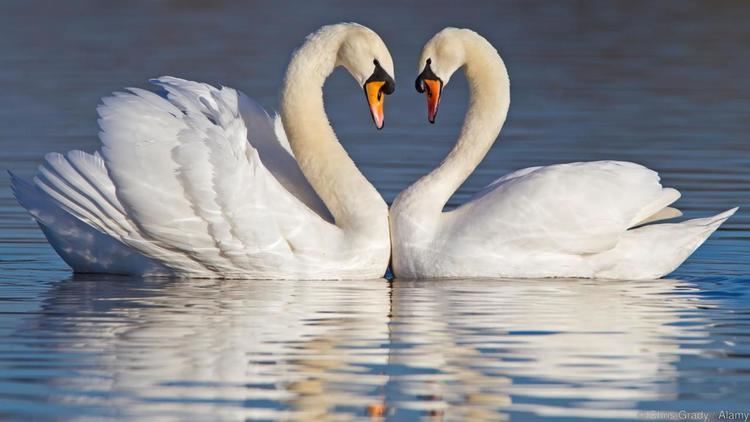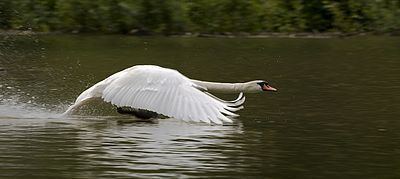Genus CygnusGarsault, 1764 Higher classification Cygnini | Phylum Chordata Scientific name Cygnus | |
 | ||
Wingspan Mute swan: 2 – 2.4 m, Black swan: 1.6 – 2 m, Whooper swan: 2 – 2.8 m Clutch size Black swan: 4 – 8, Whooper swan: 4 – 7 Length Mute swan: 1.2 – 1.7 m, Black swan: 1.1 – 1.4 m, Whooper swan: 1.4 – 1.6 m Lower classifications Mute swan, Black swan, Whooper swan, Tundra swan, Trumpeter swan | ||
Swans and cygnets at abbotsbury swannery dorset mute swan birds uk
Swans are birds of the family Anatidae within the genus Cygnus. The swans' close relatives include the geese and ducks. Swans are grouped with the closely related geese in the subfamily Anserinae where they form the tribe Cygnini. Sometimes, they are considered a distinct subfamily, Cygninae. There are six or seven species of swan in the genus Cygnus; in addition there is another species known as the coscoroba swan, although this species is no longer considered one of the true swans. Swans usually mate for life, though "divorce" does sometimes occur, particularly following nesting failure, and if a mate dies, the remaining swan will take up with another. The number of eggs in each clutch ranges from three to eight.
Contents
- Swans and cygnets at abbotsbury swannery dorset mute swan birds uk
- Exotic birds black swans
- Etymology and terminology
- Description
- Distribution and movements
- Behaviour
- Systematics and evolution
- Phylogeny
- Species
- Fossil record
- In culture
- References

Exotic birds black swans
Etymology and terminology

The English word 'swan', akin to the German Schwan, Dutch zwaan and Swedish svan, is derived from Indo-European root *swen (to sound, to sing). Young swans are known as swanlings or as cygnets; the latter derives via Old French cigne or cisne (diminutive suffix -et "little") from the Latin word cygnus, a variant form of cycnus "swan", itself from the Greek κύκνος kýknos, a word of the same meaning. An adult male is a cob, from Middle English cobbe (leader of a group); an adult female is a pen.
Description

Swans are the largest extant members of the waterfowl family Anatidae, and are among the largest flying birds. The largest species, including the mute swan, trumpeter swan, and whooper swan, can reach a length of over 1.5 m (59 in) and weigh over 15 kg (33 lb). Their wingspans can be over 3.1 m (10 ft). Compared to the closely related geese, they are much larger and have proportionally larger feet and necks. Adults also have a patch of unfeathered skin between the eyes and bill. The sexes are alike in plumage, but males are generally bigger and heavier than females.

The Northern Hemisphere species of swan have pure white plumage but the Southern Hemisphere species are mixed black and white. The Australian black swan (Cygnus atratus) is completely black except for the white flight feathers on its wings; the chicks of black swans are light grey. The South American black-necked swan has a white body with a black neck.

The legs of swans are normally a dark blackish grey colour, except for the two South American species, which have pink legs. Bill colour varies: the four subarctic species have black bills with varying amounts of yellow, and all the others are patterned red and black. Although birds do not have teeth, swans have beaks with serrated edges that look like small jagged 'teeth' as part of their beaks used for catching and eating aquatic plants and algae, but also molluscs, small fish, frogs and worms. The mute swan and black-necked swan have lumps at the base of their bills on the upper mandible.
Distribution and movements

Swans are generally found in temperate environments, rarely occurring in the tropics. A group of swans is called a bevy or a wedge in flight. Four (or five) species occur in the Northern Hemisphere, one species is found in Australia and New Zealand and one species is distributed in southern South America. They are absent from tropical Asia, Central America, northern South America and the entirety of Africa. One species, the mute swan, has been introduced to North America, Australia and New Zealand.
Several species are migratory, either wholly or partly so. The mute swan is a partial migrant, being resident over areas of Western Europe but wholly migratory in Eastern Europe and Asia. The whooper swan and tundra swan are wholly migratory, and the trumpeter swans are almost entirely migratory. There is some evidence that the black-necked swan is migratory over part of its range, but detailed studies have not established whether these movements are long or short range migration.
Behaviour
Swans feed in the water and on land. They are almost entirely herbivorous, although they may eat small amounts of aquatic animals. In the water, food is obtained by up-ending or dabbling, and their diet is composed of the roots, tubers, stems and leaves of aquatic and submerged plants.
Although swans only reach sexual maturity between 4 and 7 years of age, they can form socially monogamous pair bonds from as early as 20 months that last for many years, and in some cases these can last for life. The lifespan of the mute swan is often over 10 years, and sometimes over 20, whereas the black-necked swan survives for less than a decade in captivity. These bonds are maintained year round, even in gregarious and migratory species like the tundra swan, which congregate in large flocks in the wintering grounds. Their nest is on the ground near water and about a metre across. Unlike many other ducks and geese, the male helps with the nest construction. Average egg size (for the mute swan) is 113×74 mm, weighing 340 g, in a clutch size of 4 to 7, and an incubation period of 34–45 days. With the exception of the whistling ducks they are the only anatids where the males aid in incubating the eggs.
Swans are known to aggressively protect their nests. One man was suspected to have drowned in such an attack.
Systematics and evolution
Evidence suggests that the genus Cygnus evolved in Europe or western Eurasia during the Miocene, spreading all over the Northern Hemisphere until the Pliocene. When the southern species branched off is not known. The mute swan apparently is closest to the Southern Hemisphere Cygnus (del Hoyo et al., eds, Handbook of the Birds of the World); its habits of carrying the neck curved (not straight) and the wings fluffed (not flush) as well as its bill color and knob indicate that its closest living relative is the black swan. Given the biogeography and appearance of the subgenus Olor it seems likely that these are of a more recent origin, as evidence shows by their modern ranges (which were mostly uninhabitable during the last ice age) and great similarity between the taxa.
Phylogeny
Based on the Taxonomy in Flux from John Boyd's website.
Species
Genus Cygnus
The fossil record of the genus Cygnus is quite impressive, although allocation to the subgenera is often tentative; as indicated above, at least the early forms probably belong to the C. olor – Southern Hemisphere lineage, whereas the Pleistocene taxa from North America would be placed in Olor. A number of prehistoric species have been described, mostly from the Northern Hemisphere. Among them was the giant Siculo-Maltese C. falconeri, which was taller (though not heavier) than the contemporary local dwarf elephants (Elephas falconeri).
Fossil record
The supposed fossil swans "Cygnus" bilinicus and "Cygnus" herrenthalsi were, respectively, a stork and some large bird of unknown affinity (due to the bad state of preservation of the referred material). Anser atavus is sometimes placed in Cygnus.
The coscoroba swan (Coscoroba coscoroba) from South America, the only species of its genus, is apparently not a true swan. Its phylogenetic position is not fully resolved; it is in some aspects more similar to geese and shelducks.
In culture
Many of the cultural aspects refer to the mute swan of Europe. Perhaps the best known story about a swan is "The Ugly Duckling" fable. Swans are often a symbol of love or fidelity because of their long-lasting, apparently monogamous relationships. See the famous swan-related operas Lohengrin and Parsifal. Swan meat was regarded as a luxury food in England in the reign of Elizabeth I. A recipe for baked swan survives from that time: "To bake a Swan Scald it and take out the bones, and parboil it, then season it very well with Pepper, Salt and Ginger, then lard it, and put it in a deep Coffin of Rye Paste with store of Butter, close it and bake it very well, and when it is baked, fill up the Vent-hole with melted Butter, and so keep it; serve it in as you do the Beef-Pie."
Swans feature strongly in mythology. In Greek mythology, the story of Leda and the Swan recounts that Helen of Troy was conceived in a union of Zeus disguised as a swan and Leda, Queen of Sparta. Other references in classical literature include the belief that upon death the otherwise-silent mute swan would sing beautifully—hence the phrase swan song; as well as Juvenal's sarcastic reference to a good woman being a "rare bird, as rare on earth as a black swan", from which we get the Latin phrase rara avis, rare bird. The mute swan is also one of the sacred birds of Apollo, whose associations stem both from the nature of the bird as a symbol of light as well as the notion of a "swan song". The god is often depicted riding a chariot pulled by or composed of swans in his ascension from Delos.
The Irish legend of the Children of Lir is about a stepmother transforming her children into swans for 900 years. In the legend The Wooing of Etain, the king of the Sidhe (subterranean-dwelling, supernatural beings) transforms himself and the most beautiful woman in Ireland, Etain, into swans to escape from the king of Ireland and Ireland's armies. The swan has recently been depicted on an Irish commemorative coin.
Swans are also present in Irish literature in the poetry of W.B. Yeats. "The Wild Swans at Coole" has a heavy focus on the mesmerising characteristics of the swan. Yeats also recounts the myth of Leda and the Swan in the poem of the same name.
In Norse mythology, there are two swans that drink from the sacred Well of Urd in the realm of Asgard, home of the gods. According to the Prose Edda, the water of this well is so pure and holy that all things that touch it turn white, including this original pair of swans and all others descended from them. The poem Volundarkvida, or the Lay of Volund, part of the Poetic Edda, also features swan maidens.
In the Finnish epic Kalevala, a swan lives in the Tuoni river located in Tuonela, the underworld realm of the dead. According to the story, whoever killed a swan would perish as well. Jean Sibelius composed the Lemminkäinen Suite based on Kalevala, with the second piece entitled Swan of Tuonela (Tuonelan joutsen). Today, five flying swans are the symbol of the Nordic Countries, the whooper swan (Cygnus cygnus) is the national bird of Finland, and the mute swan is the national bird of Denmark.
French satirist François Rabelais wrote in Gargantua and Pantagruel that a swan's neck was the best toilet paper he had encountered.
A swan is one of the attributes of St Hugh of Lincoln based on the story of a swan who was devoted to him.
In Latin American literature, the Nicaraguan poet Rubén Darío (1867–1916) consecrated the swan as a symbol of artistic inspiration by drawing attention to the constancy of swan imagery in Western culture, beginning with the rape of Leda and ending with Wagner's Lohengrin. Darío's most famous poem in this regard is Blasón – "Coat of Arms" (1896), and his use of the swan made it a symbol for the Modernismo poetic movement that dominated Spanish language poetry from the 1880s until the First World War. Such was the dominance of Modernismo in Spanish language poetry that the Mexican poet Enrique González Martínez attempted to announce the end of Modernismo with a sonnet provocatively entitled, Tuércele el cuello al cisne – "Wring the Swan's Neck" (1910).
Swans are revered in Hinduism, and are compared to saintly persons whose chief characteristic is to be in the world without getting attached to it, just as a swan's feather does not get wet although it is in water. The Sanskrit word for swan is hamsa and the "Raja Hamsam" or the Royal Swan is the vehicle of Goddess Saraswati which symbolises the "Sattva Guna" or purity par excellence. The swan if offered a mixture of milk and water, is said to be able to drink the milk alone. Therefore, Goddess Saraswati the goddess of knowledge is seen riding the swan because the swan thus symbolizes "Viveka" i.e. prudence and discrimination between the good and the bad or between the eternal and the transient. This is taken as a great quality, as shown by this Sanskrit verse:
It is mentioned several times in the Vedic literature, and persons who have attained great spiritual capabilities are sometimes called Paramahamsa ("Supreme Swan") on account of their spiritual grace and ability to travel between various spiritual worlds. In the Vedas, swans are said to reside in the summer on Lake Manasarovar and migrate to Indian lakes for the winter. They're believed to possess some powers such as the ability to eat pearls.
Swans are intimately associated with the divine twins in Indo-European religions, and it is thought that in Proto-Indo-European times, swans were a solar symbol associated with the divine twins and the original Indo-European sun goddess.
